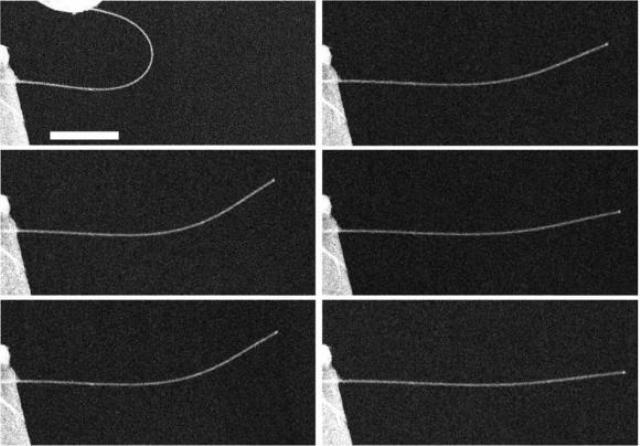Researchers from Brown University and North Carolina State University have discovered that zinc oxide nanowires are highly anelastic, and this property could make these materials useful for absorbing vibrations and shocks.
 A slow return. Zinc oxide nanowires return to shape slowly after being bent. That property, called anelasticity, suggests that nanowires might be good in applications that require absorption of shocks or vibrations. Zhu lab / NC State
A slow return. Zinc oxide nanowires return to shape slowly after being bent. That property, called anelasticity, suggests that nanowires might be good in applications that require absorption of shocks or vibrations. Zhu lab / NC State
When a material is bent, its anelastic property would enable the material to come back to its original shape slowly, instead of rapidly snapping back to its original condition. When compared to the thickness of human hair, nanoscale wires are thousands of times thinner. The findings of this study adds to the other unique properties discovered in nanoscale wires.
“What’s surprising here is the magnitude of the effect,” said Huajian Gao, the Walter H. Annenberg Professor of Engineering and a coauthor of a new paper describing the research. “Anelasticity is present but negligible in many macroscale materials, but becomes prominent at the nanoscale. We show an anelastic effect in nanowires that is four orders of magnitude larger than what is observed in even the most anelastic bulk materials.”
Anelastic materials absorb kinetic energy very well and discovering this property is quite significant. The ability to absorb kinetic energy would allow it to be used for various applications including damping vibrations and shocks.
During the last decade, zinc oxide nanowire has been recognized as one of the most important nanomaterials with a broad range of applications such as mechanical energy harvesting, solar cells, sensors and actuators. Our discovery of giant anelasticity and high energy dissipation in zinc oxide nanowires adds a new dimension to their functionality.
Huajian Gao
The experiments were carried out at NC State, in the lab of Yong Zhu, an associate professor of mechanical and aerospace engineering. Utilizing a scanning electron microscope, the nanowires were bent using a delicate apparatus. These wires rapidly returned to approximately 80% of their original shape after the strain was removed. Then within approximately 20-30 minutes, the rest of the material's original shape was slowly recovered. This phenomenon designates a comparatively more prominent anelastic effect at the nanoscale than that observed at the macroscale.
Zhu and his team collaborated with Gao’s lab at Brown University to find out the reason for this outstanding effect. Gao’s lab conducts studies on theoretical modeling of nanoscale systems. Gao and his colleagues developed a model which proposed that the anelasticity could be due to impurities existing in the crystal lattice of the nanowires.
Impurities in lattices exist in two forms - interstitials and vacancies. In interstitials extra atoms would exist on the lattice, and in vacancies atoms would be missing. When a wire is bent in an arch shape, the arch's underside has a comparatively higher compressive strain than the upper side of the arch. Interstitial atoms are pushed towards the outside edge due to the compression, and the vacancies are drawn in the inner direction. After the compressive strain is released, migration of the impurities takes place and they go back to their original location. This migration occurs slowly, and hence it takes some time for the wire to return to its original shape. However, as nanowires are very small, a notable anelastic effect can be generated with the impurities only having to travel very small distances. Hence, when compared to the macroscale, the anelastic effect is significantly more prominent at the nanoscale.
In order to determine whether impurities were the main cause of the anelastic property, the researchers conducted studies on silicon material wires doped with boron impurities. Experiments proved that the doped silicon was also anelastic.
The observations made in this study suggest that single-crystal nanowires could be having anelasticity as a common property. “One reviewer [of our paper] commented that this is a new important page in the book on mechanics of nanostructures,” Zhu said. "The factors that favor anelasticity, such as high strain gradient, short diffusion distance and large diffusivity of point defects, are all prominently present in nanowires".
The findings of this study have been published in Nature Nantechnology journal.
Other contributors to this study include Hamed Haftbaradaran and Chunyang Miao from Brown University; and Qingquan Qin, Feng Xu, Jing Li, Elizabeth C. Dickey and Guangming Cheng, from NC State.
The National Science Foundation has provided support for this study.
References